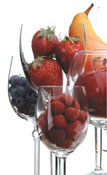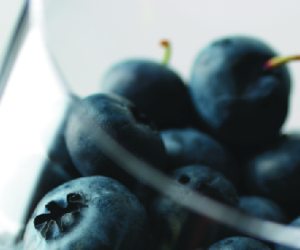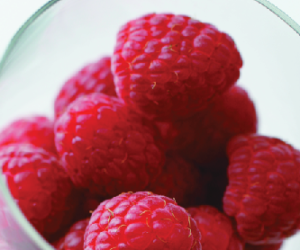 Did you ever think, “I’m sick of dealing with grapes! Finding them, transporting them, crushing them! It’s a hassle! I want something easier!”
Did you ever think, “I’m sick of dealing with grapes! Finding them, transporting them, crushing them! It’s a hassle! I want something easier!”
If you have, you’re in luck, because this issue’s tips focus on making “country wines”— those delicious beverages derived from almost any fruit, a little bit of coaxing, some careful balancing and strict attention to detail. Nearly every fruit can be turned into wine, but you might be wondering exactly how to do it.
The good news is, fruit is easier to get than grapes. Which fruit you will use is a case of personal preference and some experimentation. Our pros talk about some of the most user-friendly fruits, and warn against using others. And they all recommend using frozen fruit when making country wines. So read their tips carefully and take their advice to heart before jumping into this new winemaking adventure!
Winemaker Fred Strothman of Confre Cellars in Palisade, Colorado does business as Rocky Mountain Meadery and St. Kathryn Cellars. Fred took winemaking courses at U.C. Davis and Cornell. He has been at Confre Cellars since they opened the doors in 1995.
We’re not too scientific about which fruits we use for our country wines. We just look around and try to pick things that will be fun to make. Right now we are making wines called “Cranberry Kiss” and “Blueberry Bliss.” They are really unique, fun wines that you just can’t find at a store.
We also once made a “Strawberry Rhubarb” wine that won the People’s Choice award in the region. The key to country wines is getting the fruit. You usually need about 3 to 6 pounds per gallon of wine. We usually go with frozen fruit because freezing breaks down the cellular structure, making fermentation easier. Frozen fruit doesn’t need crushing to break up the fruit and separate out the juice. It makes for easier winemaking, and is available year-round.
The only fruits we don’t buy frozen are apricots and peaches, because these tend to brown when exposed to air. It’s better to get them fresh and crush them by hand. We do throw away the pits, since they have hydrogen cyanide in them. Not only does cyanide lend a bad taste to the wine, it could also be poisonous.
Country wine fruits are typically low in sugar, so you’ll need to add sugar to get the type of wine you want. Say we’re making a cherry wine. We put the frozen cherries in a container to start them thawing. Then I put on sterile rubber gloves and squeeze the cherries by hand to get the juice out and run it in a centrifuge to separate away the solids. At home, you could put the fruit in a cheesecloth bag and squeeze out the juice. After I get a nice, clear juice, I do tests with a refractometer and a saccharometer to determine sugar content. A hydrometer will also suffice.
Once you know how much sugar you have in solution, you can calculate how much you need to add. Any good winemaking book will give you the equations to determine the amount of sugar you need to add. You generally stop adding sugar when you reach 21° to 22° Brix. Ordinary table sugar works just fine for this. We use Prise de Mousse yeast because it’s strong and healthy, with no off-flavors or smells. But you can use virtually any yeast.
—
Winemaker Denny Franklin of Pheasant Hollow Winery in Whittington, Illinois. Denny used to be a coal miner and learned winemaking at home. He has been at Pheasant Hollow for three years. His marionberry wine won a double gold for best fruit wine in Illinois.
Sugar isn’t such a big deal in the fruits you pick for country wines, since you’re going to add sugar in the recipe to get it up to around 21° Brix. When you ferment, this will get you 11 percent alcohol. We use cane sugar for this, since it’s cheap. And if we need to sweeten the wine at the end of fermentation, we’ll use cane sugar for that, too.
You really should be more interested in acidity so that you balance the sweetness in the wine without having to add citric acid. Red raspberries and blackberries are two fruits with good acid levels. The correct acid level will depend on the fruit. Our blueberry wine had a 0.70 acid level, and that was about right for that kind of fruit wine. Acid readings of 0.90 to 1.2 percent generally make for a sweeter wine.
Frozen fruit is the best way to make country wines, since it helps break down the fruit and promotes fermentation. We just thaw it in a tub and when it’s almost thawed, we add the sugar to get those levels to where we want them. Skins contain desirable flavor materials, so keep them in the must. Plums, prunes, apricots, peaches and most berries are fermented with the juice. Keep the pulp and skins together for a few days to extract flavors. If necessary, we’ll add some water to the must, though we try to add as little water as possible to ensure bold fruit flavors in our wines. But some fruits, like blueberries, do need water because there’s just not much natural juice in a blueberry. In something like a raspberry, however, you rarely need to add water.
A good way to simplify the separation of the skin and pulp is to enclose them all in a big cheesecloth and then submerge it in the juice and water mixture in the fermenter. As fermentation winds down, you can remove the bag without a problem. It also works well to crush the fruit or just run it through a food processor, then mix the water, fruit, juice and sugar together and rack off the solids near the end of fermentation.
You can also add some pectic enzymes. Adding pectic enzymes will help break down the fruit some more. The fruit will continue to thaw and, when it hits 50° F (10° C), add the yeast by sprinkling it on top of the must. Punch down twice a day and press off the skins when fermentation is done. When the Brix levels hit around 13°, either remove your cheesecloth with the pulp and skins, or rack carefully off the solids into a closed fermenter that’s fitted with an airlock.







